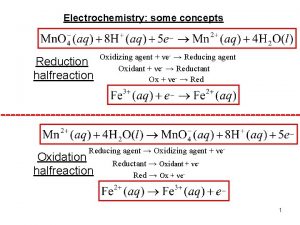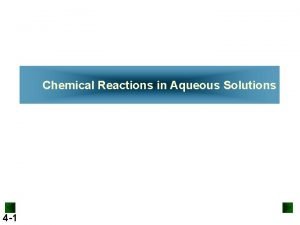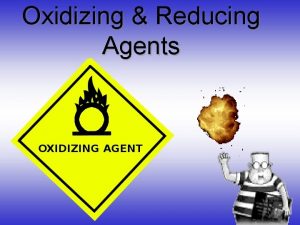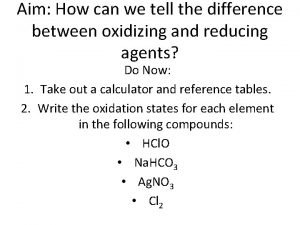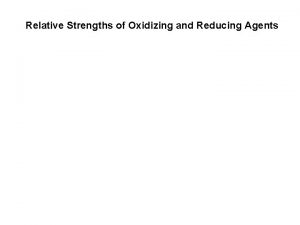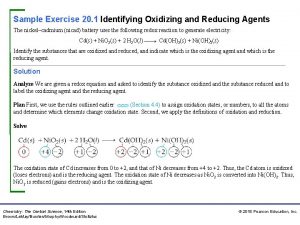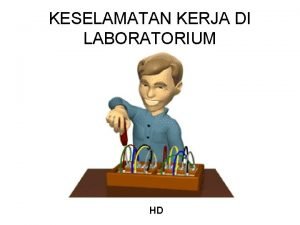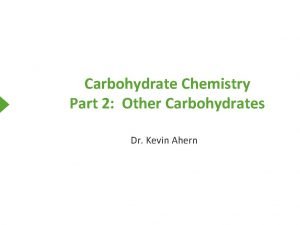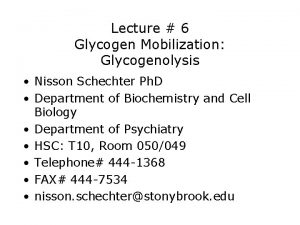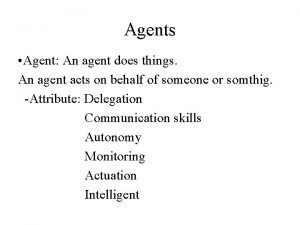Oxidizing Reducing Agents Oxidizing Agents An oxidizing agent











- Slides: 11

Oxidizing & Reducing Agents

Oxidizing Agents An oxidizing agent, or oxidant, gains electrons and is reduced in a chemical reaction. Reducing Agents A reducing agent, or reductant, loses electrons and is oxidized in a chemical reaction. oxidized reduced 0 +2 -2 Mg(s) + S(s) Mg S(s) Reducing Agent Oxidizing Agent


GER Gains Electrons Reduction LEO Loses Electrons Oxidation r. OAR Oxidizing Agent Reduced

Reference Table J Strongest reducing agent – Oxidize the most Strongest oxidizing agent – Reduce the most

Oxidizes – Reducing Agent Reduces – Oxidizing Agent Fe vs. Cu Fe Cu Mn vs. Co Mn Co Br 2 vs. I 2 Br 2

How to Identify Reducing and Oxidizing Agents Cl 2 (aq) + 2 Br- (aq) 2 Cl- (aq) + Br 2 (aq) Oxidation: 2 Br- (aq) Br 2 (aq) Oxidation States: -1 0 Reduction: Cl 2 (aq) 2 Cl- (aq) Oxidation States: 0 -1 * Br- loses an electron; it is oxidized from Br- to Br 2. Br- is the reducing agent. * Cl 2 gains one electron; it is reduced from Cl 2 to 2 Cl-. Cl 2 is the oxidizing agent.

Oxidizing Reducing Agents Oxidation Decreases Increases State # of Gained Lost Electrons Substance Reduced Oxidized is

Learning Check: Which are the oxidizing and reducing agents? Pb + Na. NO 3 Pb. O + Na. NO 2 0 +1 +5 -2 +2 -2 +1 +3 -2 Pb loses 2 e- to become Pb+2, so it is oxidized. N+5 gains 2 e- to become N+3, so it is reduced.

Calculating Potentials Chart on p. 469 shows reduction potentials *For oxidation: reverse rxn, change the sign What is the maximum voltage that can be obtained from an electrochemical cell with Zn/Zn 2+ and Cu/Cu 2+? Use Table J to see which oxidizes or reduces. Zn oxidizes, Cu reduces Reduces: Cu 2+ + 2 e- Cu 0. 34 V Oxidizes: Zn 2+ + 2 e- 0. 76 V 1. 10 V ** Positive voltage = spontaneous

Learning Check: Using the table of standard potentials (p. 469), calculate theoretical voltage. Cu/Cu 2+ and Mg/Mg 2+ Oxidation: Mg 2+ + 2 e. Reduction: Cu 2+ + 2 e- Cu 2. 37 V 0. 34 V 2. 7 V Mg/Mg 2+ and Zn/Zn 2+ Oxidation: Mg 2+ + 2 e 2. 37 V Reduction: Zn 2+ + 2 e- Zn - 0. 76 V 1. 6 V
 Cell potential table
Cell potential table Oil rig oxidation
Oil rig oxidation Which is the oxidizing agent?
Which is the oxidizing agent? Differentiate between oxidizing and reducing agents
Differentiate between oxidizing and reducing agents Relative strength of oxidizing and reducing agents
Relative strength of oxidizing and reducing agents Identify oxidizing and reducing agents practice
Identify oxidizing and reducing agents practice Chlorine oxidizing agent
Chlorine oxidizing agent Milady chapter 20 test
Milady chapter 20 test Oxidizing agent artinya
Oxidizing agent artinya Reducing sugar vs non reducing sugar
Reducing sugar vs non reducing sugar Bials test
Bials test Fates of glucose
Fates of glucose
